Each week, we'll be bringing you select insights from our newsletter, How to Build Brands and Influence People (HBBIP). To have all of these insights delivered directly to your inbox, subscribe today!
Pop quiz: name the two biggest quick-service restaurant franchises in America by sales.
Here’s a hint: if I asked you to just name the first two quick-service restaurants to come to mind, you’d probably reach the same answer.
That’s right…it’s McDonald’s and Starbucks! Two great tastes that taste great together, maybe.
So now that we’ve identified our two top brands, we come to the age-old question: do CreatorIQ’s metrics bear out the dominance of McDonald’s and Starbucks?
You already know they do. Check out our top five:
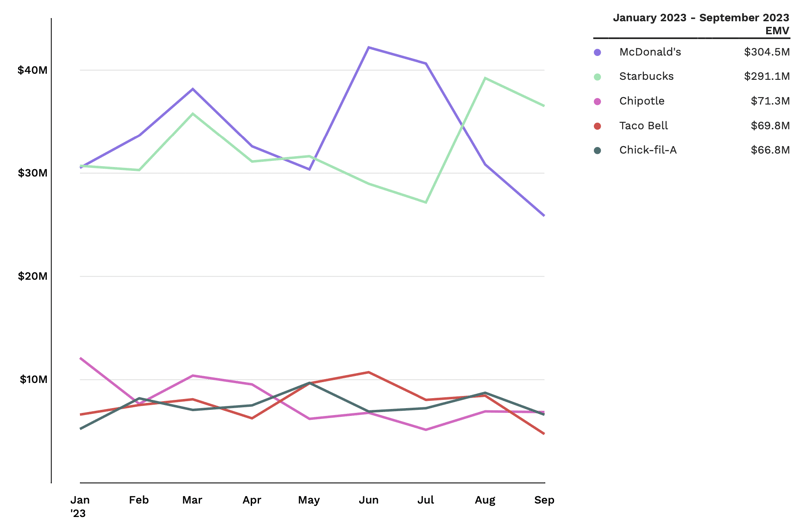 Top 5 Quick-service Restaurants by Earned Media Value
Top 5 Quick-service Restaurants by Earned Media Value
Clearly, McDonald’s and Starbucks are in a league of their own. They’re not just America’s foremost QSRs by revenue—they’re some of the internet’s favorite brands, period. But if we zoom and enhance on these two industry leaders, we notice a few interesting things:
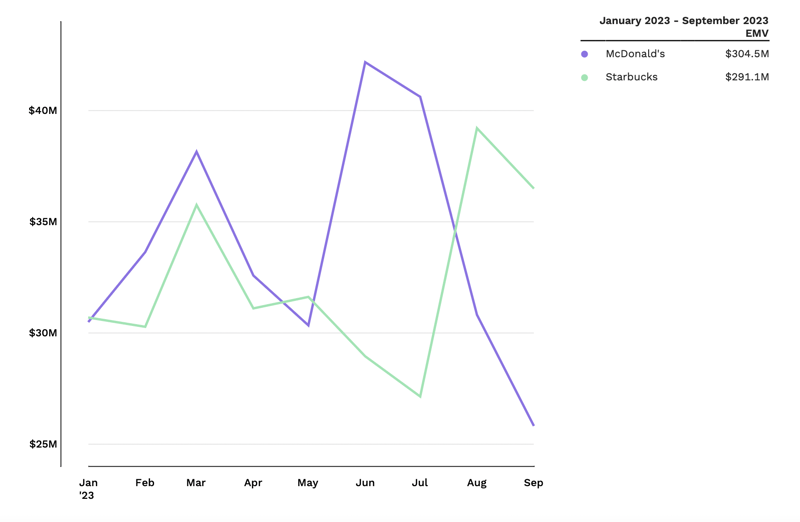 McDonald's and Starbucks 2023 EMV performance
McDonald's and Starbucks 2023 EMV performance
Interesting Thing #1: What Was McDonald’s Getting up to in June?
You might notice that dramatic spike for McDonald’s in June. Since summer isn’t Shamrock Shake season, it begs the question: what was driving this success for McDonald’s?
The answer is right there in the purple shade used for McDonald’s in the graph. In June, the fast-food franchise introduced a range of menu items themed around everyone’s favorite ‘large, purple, rotund being of indeterminate species,’ Grimace. (And yes, that is a link to the official McDonald’s wiki, which is a thing that exists. Don’t say that this newsletter hasn’t taught you anything.)
With creators racing to try the viral Grimace Shake, McDonald’s soared across a range of metrics, including Engagement and Impressions:
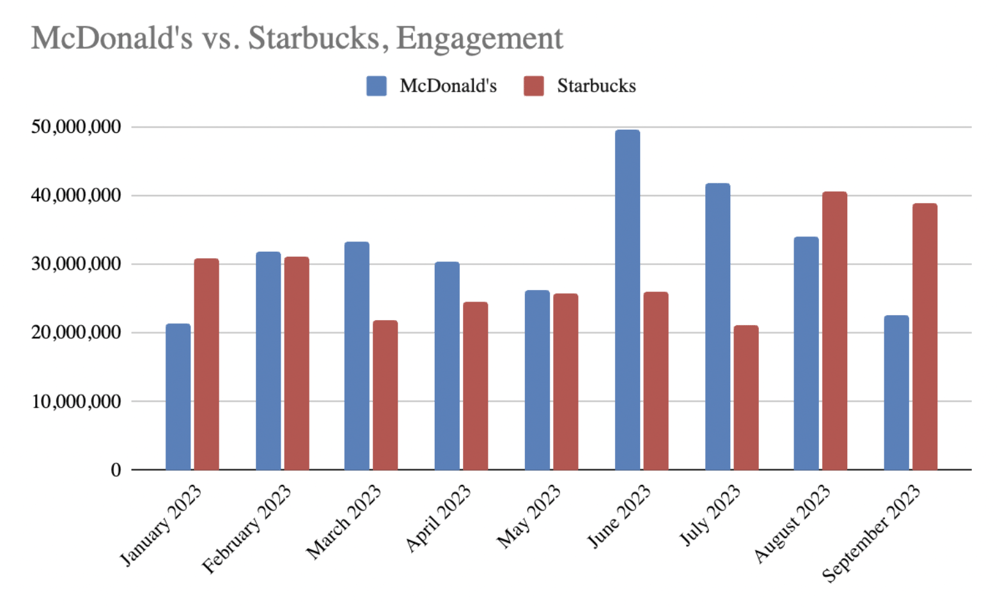 McDonald's vs Starbucks Engagement January - September 2023
McDonald's vs Starbucks Engagement January - September 2023
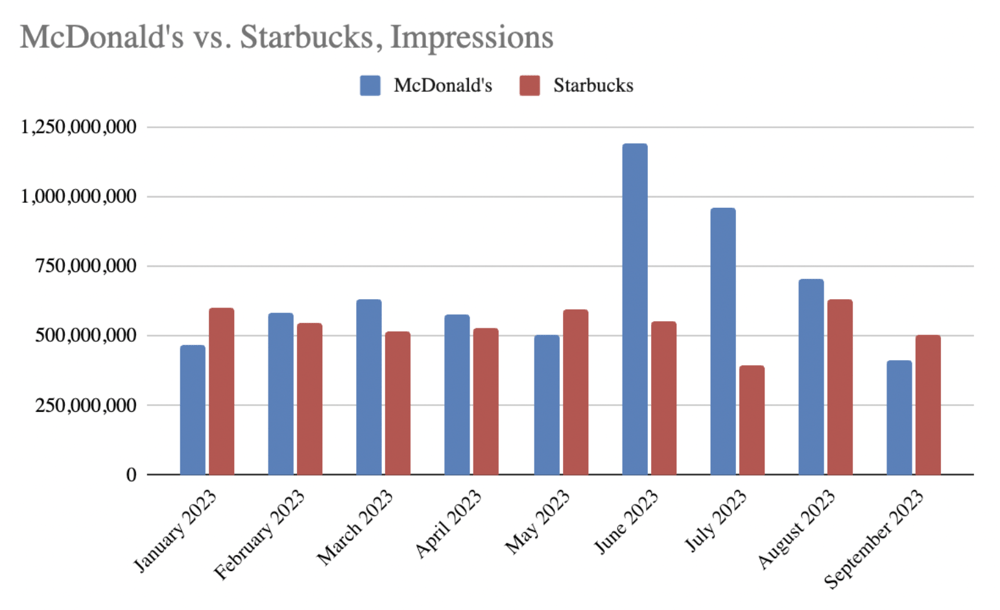 McDonald's vs Starbucks Engagement January - September 2023
McDonald's vs Starbucks Engagement January - September 2023
With McDonald’s hitting unmatched heights in June and July, it’s clear that nostalgia can be a particularly powerful force for influencer marketing campaigns around quick-service restaurants. Move over, Taylor Swift: 2023 was the summer of Grimace!
Interesting Thing #2: What’s Starbucks Getting up to Now?
While it might not have matched the levels seen at the peak of Grimace-mania, Starbucks enjoyed considerable momentum in August and September, pulling ahead of McDonald’s in both EMV and Engagement.
Time for another pop quiz: what’s something at the end of summer that could drive online buzz for Starbucks? Yes, as if last week’s coverage of Ms. Swift’s exploits weren’t basic enough, this week I’m here to tell you about Pumpkin Spice Lattes.
2023 marked the 20th anniversary of the iconic beverage, and to celebrate, Starbucks introduced a third pumpkin drink to its menu—the Iced Pumpkin Cream Chai Latte. Because some folks just can’t wait for fall, the pumpkinpalooza kicked off in August, supercharging Starbucks just as McDonald’s declined from its summer campaigns.
Interesting Thing #3: Will These Trends Hold?
We’ve seen Starbucks and McDonald’s go back and forth throughout 2023, fighting neck and neck for QSR supremacy. But who will wear the crown as the year comes to a close?
Well, if history is any guide, it’s going to be another close one.
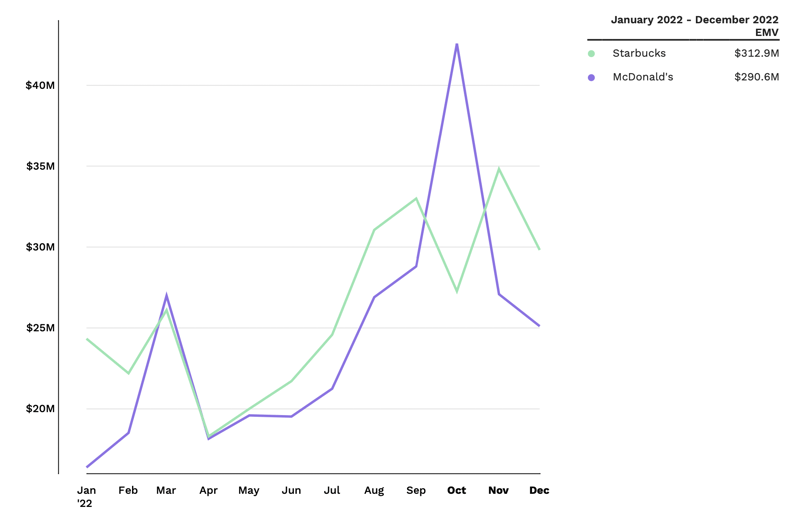 Starbucks vs. McDonald's 2022 Performance
Starbucks vs. McDonald's 2022 Performance
While Starbucks closed the year strong thanks to internet hype surrounding its holiday drinks, McDonald’s saw another huge surge in October 2022. Like its Grimace campaign in 2023, McDonald’s tapped into consumers’ nostalgia by introducing adult happy meals. Naturally, much like a happy meal toy, the internet broke.
With 2024 approaching, I’ll be sure to check in on our heavyweights in a future edition of this newsletter, and keep you posted on whether the top spot is seized by Ronald or, uh, the mermaid lady. In case you doubted just how close this battle is, consider both brands’ EMV totals from January 2022 to September 2023:
- Starbucks: $604,029,971
- McDonald’s: $595,118,725
That’s just a 1.5% difference! People just can’t decide whether they prefer Grimace shakes or PSLs. I might have to try a few more of each myself—you know, for research purposes.
This Week’s Headlines
We—by which I mean I—have spent the past week searching high and low for stories about key developments in the Creator Economy. So what did I find?
Harvard 🤝TikTok 🤝Mental Health
Key Takeaways:
-
- A cool story from the New York Times shows how researchers at Harvard’s T.H. Chan School of Public Health have built a powerful creator squad.
- By reaching out to key figures in Mental Health TikTok—a diverse group of therapists, comedians, and everyday folks—Harvard is hoping to seed viral content with facts, statistics, and peer-reviewed research.
- The whole article is worth a read, but the experiment was a success: “The 42 influencers who received Harvard’s talking points were 3 percent more likely to post content on the core themes researchers had fed them. Although that may seem like a small effect, each influencer had such a large audience that the additional content was viewed 800,000 times.”
The CIQ Perspective:
-
- Every day we watch more and more institutions embrace the creator economy, and recognize that it’s the most effective way to reach contemporary audiences.
- Sometimes people are tempted to dismiss creators, but here’s a tangible example in which creators are promoting positive messages—and even saving lives.
- If creator marketing is good enough for Harvard, it’s probably good enough for your brand. Even if your brand probably has less grade inflation.
Yet Another Study Confirms That Gen Z Loves Small-Scale Creators
Key Takeaways:
-
- As reported by Adweek, a Morning Consult poll of 2,204 adults and 1,000 Gen-Zers (age 13 and up) found that young consumers pay close attention to, and prefer to follow, nano- and micro-creators.
- 71% of respondents defined creators as anyone who “makes entertaining content,” while 70% said a creator will “share ideas or inspiration,” and 61% said a creator should “share advice.”
- Want to build trustworthy content to promote your brand? Turn to creators. In 2019, 51% of millennial and Gen-Z consumers reported trusting creators. This year, 61% did.
The CIQ Perspective:
-
- I’ve said it before and I’ll say it again: I am not a business expert. I am just a humble newsletterman. But if you’ve got consumers saying that they trust a particular group in an era when trust in businesses/the internet/institutions/the world at large is at a low point, then it probably behooves you to work with that group.
- I know what you’re thinking: working with that group is probably expensive. But actually, working with small-scale creators is one of the most cost-effective ways to reach—and truly engage with—a wider audience.
- Look out for more stats that reinforce the magic of small-scale creators, and creator marketing more broadly, in our forthcoming Trends Report.
The World Series of Influencing
Key Takeaways:
-
- Per Digiday, the MLB is looking to leverage social media creators to promote the upcoming World Series, reaching full saturation with channels and demographics not typically attuned to baseball.
- Via a combination of humor, mascot shenanigans, and human-interest stories featuring star players, the MLB’s owned accounts are getting into the fun on YouTube and TikTok—particularly the latter.
- Additionally, the league will partner with 12 creators across technology, fashion, travel, and gaming, all of whom are baseball fans, for multiple World Series activations. This program will serve as a test for a broader series that will be rolled out next season.
The CIQ Perspective:
-
- This is a savvy move from the MLB, and further confirmation that creators are key to any winning promotion strategy for leading cultural phenomena and events.
- The MLB’s program comes on the heels of a similar program from the NFL, along with increasing ties between creators and the NBA, underscoring the symbiotic relationship between professional sports and the Creator Economy.
- This seems like a great time to plug our new individualized rankings of social media’s top MLB and NFL teams—with NBA and NHL updates coming next month.
To get all of these stories, plus much more, delivered to your inbox weekly, be sure to subscribe to our newsletter.

